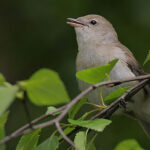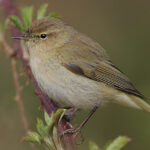- Scientific Classification: Bowfinches belong to the genus Pyrrhula within the family Fringillidae.
- Common Species: The Eurasian Bullfinch (Pyrrhula pyrrhula) is one of the most well-known species of bowfinches.
- Geographical Distribution: Bowfinches are primarily found across Europe and Asia.
- Habitat: These birds favor deciduous and mixed forests, particularly with dense understory, but can also be found in gardens and parks.
- Physical Appearance: Bowfinches are known for their striking coloration, with males often sporting bright red or orange underparts and black caps.
- Size: They are medium-sized finches, typically measuring around 5.5 to 6 inches (14-16 cm) in length.
- Weight: An adult bowfinch usually weighs between 20 and 27 grams.
- Beak Shape: They have strong, conical beaks adapted for seed eating.
- Diet: Bowfinches primarily eat seeds, but they also consume buds, berries, and insects, especially during the breeding season.
- Vocalization: Their call is a soft, melancholic whistle, which is quite distinctive and easily recognizable.
- Breeding Season: The breeding season for bowfinches typically starts in late spring and can continue through the summer.
- Nesting Habits: They build cup-shaped nests in bushes or trees, often concealed in dense foliage.
- Eggs: A typical clutch consists of 4-6 eggs, which are pale blue with reddish-brown spots.
- Incubation Period: The eggs are incubated for about 12-14 days by the female.
- Fledgling Stage: The chicks fledge roughly two weeks after hatching but remain dependent on their parents for some time.
- Lifespan: In the wild, bowfinches can live up to 8 years, although many do not survive this long due to predation and other risks.
- Predators: Common predators include hawks, owls, and domestic cats.
- Social Behavior: Bowfinches are generally monogamous and tend to stay in pairs throughout the year.
- Winter Behavior: In winter, they often form small flocks to forage for food.
- Molting: They undergo a molt after the breeding season, replacing their feathers gradually.
- Migration: Some populations are partially migratory, especially those in colder regions, moving to milder areas during winter.
- Conservation Status: Most bowfinch species are not currently endangered, although habitat loss and climate change pose future threats.
- Cultural Significance: In some cultures, bowfinches are considered symbols of love and fidelity due to their strong pair bonds.
- Scientific Research: Bowfinches are often studied for their distinctive song patterns and vocal learning abilities.
- Feeding Habits: They have a unique way of feeding on buds by stripping them from trees, which can sometimes cause significant damage to orchards.
- Plumage Changes: The bright plumage of males fades slightly outside the breeding season, becoming more subdued.
- Sexual Dimorphism: There is a noticeable difference between males and females, with females typically having more muted colors.
- Longevity Records: The oldest known wild bowfinch lived to be over 10 years old.
- Banding Studies: Banding has provided valuable data on their movement patterns and lifespan.
- Adaptability: Bowfinches have shown remarkable adaptability to changing environments, often thriving in suburban areas where suitable habitat remains.
Frequently Asked Questions About Bowfinches
1. What is a bowfinch? A bowfinch refers to birds in the genus Pyrrhula, known for their vibrant colors and strong beaks, commonly found in Europe and Asia.
2. Where do bowfinches live? Bowfinches inhabit deciduous and mixed forests with dense undergrowth, but they can also be found in gardens and parks.
3. What do bowfinches eat? Their diet consists mainly of seeds, but they also consume buds, berries, and insects, particularly during the breeding season.
4. How can I identify a bowfinch? Bowfinches are medium-sized with a length of 5.5 to 6 inches. Males have bright red or orange underparts and a black cap, while females are more muted in color.
5. Are bowfinches migratory? Some bowfinch populations are partially migratory, especially those in colder regions, moving to milder areas during winter.
6. How do bowfinches build their nests? They build cup-shaped nests in bushes or trees, often hidden in dense foliage. The nests are usually constructed with twigs, moss, and grass.
7. When is the breeding season for bowfinches? The breeding season typically begins in late spring and can extend through the summer.
8. How many eggs do bowfinches lay? A typical clutch contains 4-6 pale blue eggs with reddish-brown spots.
9. How long do bowfinch eggs take to hatch? The eggs are incubated for about 12-14 days before hatching.
10. How long do bowfinches live? In the wild, bowfinches can live up to 8 years, although many do not reach this age due to predation and other risks.
11. What are the main predators of bowfinches? Common predators include hawks, owls, and domestic cats.
12. Do bowfinches have a distinctive call? Yes, their call is a soft, melancholic whistle, which is quite distinctive and recognizable.
13. Are bowfinches endangered? Most bowfinch species are not currently endangered, but habitat loss and climate change pose future threats.
14. How do bowfinches adapt to winter? In winter, bowfinches often form small flocks to forage for food and may migrate to milder regions.
15. What is the significance of bowfinches in culture? In some cultures, bowfinches symbolize love and fidelity due to their strong pair bonds.
16. How can I attract bowfinches to my garden? Planting native trees and shrubs that produce seeds and berries, and providing a water source can attract bowfinches to your garden.
17. How do bowfinches molt? Bowfinches undergo a molt after the breeding season, replacing their feathers gradually.
18. Can bowfinches be kept as pets? While not commonly kept as pets, some people do keep bowfinches in aviaries. However, it’s essential to ensure they have a suitable environment and diet.
19. How do bowfinches feed on buds? They strip buds from trees with their strong beaks, which can sometimes cause damage to orchards.
20. Do male and female bowfinches look different? Yes, males are typically more brightly colored with red or orange underparts, while females have more muted colors.
21. How do bowfinches communicate? Besides their distinctive calls, bowfinches use body language and behavior to communicate with each other.
22. What is the scientific name for the Eurasian Bullfinch? The scientific name for the Eurasian Bullfinch is Pyrrhula pyrrhula.
23. How can I help conserve bowfinches? Supporting habitat conservation efforts, planting native flora, and minimizing pesticide use can help conserve bowfinch populations.
24. What kind of research is done on bowfinches? Bowfinches are studied for their distinctive song patterns, vocal learning abilities, and ecological behaviors.
25. How do bowfinches respond to habitat changes? Bowfinches have shown adaptability to changing environments and can thrive in suburban areas with suitable habitats.
26. What is the lifespan of the oldest known bowfinch? The oldest known wild bowfinch lived to be over 10 years old.
27. Are bowfinches social birds? Bowfinches are generally monogamous and stay in pairs, but they form small flocks in winter for foraging.
28. Do bowfinches have any unique feeding behaviors? Yes, their method of stripping buds from trees is unique and can be both beneficial and harmful depending on the context.
29. What are the main threats to bowfinches? Habitat loss, climate change, and predation are the main threats to bowfinch populations.
30. How do bowfinches care for their young? Both parents feed the chicks after they hatch, and the young remain dependent on their parents for some time even after fledging.





